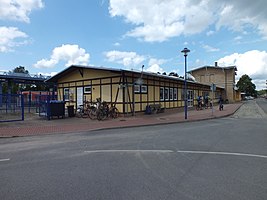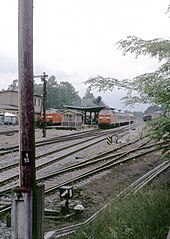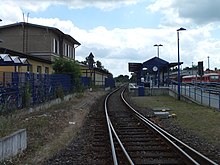Basdorf station
| Basdorf | |
|---|---|
|
Goods shed and reception building on Bahnhofstrasse
|
|
| Data | |
| Operating point type | railway station |
| Location in the network | Separation station |
| Design | Through station |
| Platform tracks | 2 |
| abbreviation | BBAS |
| opening | 1901 |
| location | |
| City / municipality | Wandlitz |
| Place / district | Basdorf |
| country | Brandenburg |
| Country | Germany |
| Coordinates | 52 ° 42'55 " N , 13 ° 26'2" E |
| Railway lines | |
|
|
| Railway stations in Brandenburg | |
The Basdorf train station is a station of Heidekrautbahn . It is located at kilometer 17.4 of the original route from Berlin-Wilhelmsruh and is the separation station for the two branches of the Heidekrautbahn to Groß Schönebeck and Liebenwalde . Soon after the line went into operation, the station became very important for the operation of the Heidekrautbahn.
history
Basdorf train station was built in 1901 as a provisional facility, its buildings were finished in 1905 and it officially went into operation. It quickly developed into the operating center of the Niederbarnimer Railway (NEB), also called the Heidekrautbahn after one of its endpoints in the Schorfheide . It received a railway depot and there were supply systems for the steam locomotives. In the train station the branches to Liebenwalde and Groß Schönebeck separate.
Close to the train station, the railway company had a small settlement with two-story apartment buildings built for its employees, which was renovated in the 1990s and continues to be used for residential purposes.
During the construction of the line from Karow to Fichtengrund, the Basdorf station facilities remained essentially unchanged.
The depot was downsized after 1990, some tracks were removed, and a new locomotive shed was inaugurated in 1995.
The Niederbarnimer Railway renovated the station after 2000. At the same time, the members of the Berlin Railway Friends Association opened the Heidekrautbahnmuseum in a building and in parts of the open space . The destination indicator from the Basdorf train station, part of a bench from the platform, the mechanical manual interlocking and numerous pieces of technology went to the museum as exhibits.
description
As the central station of the Niederbarnimer Railway (NEB), which went into operation in 1901 , also known as the Heidekrautbahn after one of its endpoints in the Schorfheide , the station had facilities such as locomotive sheds, repair shops, locksmiths and carpenters, loading facilities (coal storage, Coal crane, water crane ) and shunting tracks two passenger platforms. A tunnel from the station building led to these . At the platforms, passengers to or from the sections of the route switched to a shared train unit from or to Berlin. Or the railroad workers uncoupled the wagons and some of the wagons were hauled by a new tractor. It was possible to change sides either directly on a platform by changing sides or the tunnel to the other platform had to be used.
The tunnel led from the station building in Bahnhofstrasse to both parts of the platform. Directly at the two-story entrance building, which had been built from exposed bricks , there was an attached timber-framed goods shed , which, among other things, also served as luggage storage. After the fall of the Wall , the district library moved here.
In 1998 the entire route of the Heidekrautbahn and all stations, including Basdorf station, was transferred back to the Niederbarnimer Eisenbahngesellschaft (NEB). While DB Regio continued to carry out passenger transport for a number of years, this has been carried out by NEB Betriebsgesellschaft since 2005.
The railroad depot included a dispatcher interlocking built by the Deutsche Reichsbahn , which was in operation until the late 1990s. The Jüdel type lever bench was operated mechanically using wire ropes.
The station has an island platform with two platform edges. During an extensive renovation, this was covered with ceramic tiles. In the beginning there was rolled chippings as platform surfaces, later stone slabs protected the platforms. The original tunnel was filled in and a level crossing was made with a ramp to the platform for barrier-free access .
Since the 2010s, operations have been carried out almost exclusively with three-part articulated vehicles of the Talent type .
Literature and source
- Jürgen Opravil: The Heidekrautbahn. History of the Reinickendorf – Liebenwalde – Groß Schönebecker Railway, later Niederbarnimer Railway. Chronik Pankow, 1993, pp. 119-121.
Web links
- Basdorf Railway Museum and a short chronicle of the Heidekrautbahn; numerous historical photos from the Bh. Basdorf
- Track plan of the entire Basdorf station in 1982



